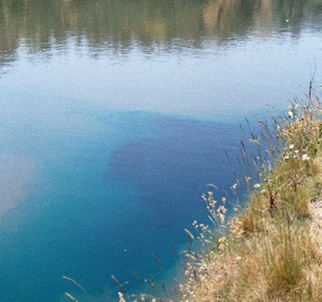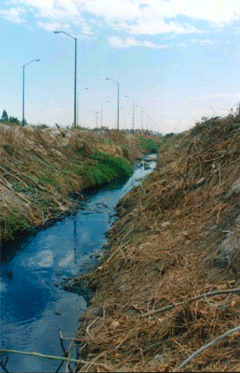Information about Jeans ™

back to News, Products & Services
Jeans Environment
TEHUACAN, Mexico (Reuters) - Jeans factories have given jobs to thousands in the city of Tehuacan, the heartland of Mexico's denim industry, but they are pumping blue chemicals into rivers used to irrigate corn fields downstream.
JEANS factories in Tehuacan, the heartland of Mexico`s denim industry, are turning rivers blue with the chemicals used to dye jeans.
Dozens of industrial laundries, some of which put the finishing touches to jeans for export, discharge a cocktail of bleach, dye and detergents into Tehuacan`s rivers with almost no government controls, residents say.
Not all jean companys are polluting the planet. Take Dorinha Jeans, they started up 2001 and and ever since have been making jeans while protecting the environment.
A water cleaning facility at Dorinha Jeans factory in Brazil.
---
Want to save the planet? Wear your jeans two days a week, wash them every fifth day, and let them dry by themselves. Or better still don't wash them at all. And don't even think of ironing them.
---
It’s not easy, being green. Or Indigo for that matter…
So when I first meet someone and the inevitable question of what I “do” comes up in conversation. The answer is usually met with some sort of the following:
a) strange brow furrowing and nose twitching
b) blank stare
c) snicker
d) snicker followed by “So, like, what? Hemp?”
Ah, the joys of being an eco-fashion designer! What does all this mean? Do I have to wear hemp? Do I have to be vegan? What the hell is mud dye anyway? Being a fashion designer and being organic and sustainable used to be worlds apart. The reason? Because high quality organic and sustainable fashion fabrics were in short supply (if available at all.) Organic cotton? What for? Why? Sustainable and organic wool? What’s the difference? Why bother? What was available 10 years ago was natural hemp and linen. Not a whole lot else. That isn’t true anymore. But maybe I’m getting ahead of myself. Maybe you need to know WHY before we go anywhere else.
The fashion industry is one of the most pollutant causing industries in the world. From the farming of raw materials to washing of the final product, almost every step there is an opportunity for greening. Since I work in the denim industry I feel like I am most qualified to talk about the greening steps involved in one pair of simple jeans. This is a long article but I feel if you begin to understand what goes into something as simple as pants you can see the sum gain of the larger picture.
Jeans, and in specific cotton, is one of the most pollutant pieces of clothing that any one person can own. Unfortunately it takes 2/3 of a pound of pesticides to make one pair of jeans, and 1/3 of a pound to make a single T-shirt. A pair of jeans only weighs about a pound! That sort of ratio is unheard of in any other crop. While conventional cotton accounts for 2% of global agriculture it requires 10% of global pesticide use. The EPA says that conventional agriculture is responsible for 70% of all problems in U.S. rivers and streams.
When it comes to going organic in fashion there are certain criteria, just like food, that need to be followed. Organically grown cotton has been produced without the use of chemical fertilizers and pesticides. A field must be pesticide free for three years for the cotton to be certified organic. This insures that the land is free of any residual chemicals that could enter into the plants and cause contamination.
Why is contamination important? According to the EPA, five of the top nine pesticides used in cotton production in the US (cyanide, dicofol, naled, propargite, and trifluralin) are known cancer-causing chemicals. The EPA classifies all five pesticides as Category I and II, the most dangerous of chemicals. While these pesticides are washed out by the time the cotton gets ginned, farm workers suffer the most by being in direct contact with many of these chemicals. The World Health Organization estimates accidental pesticide poisoning causes 20,000 deaths and 3 million non-fatal poisonings every year, worldwide. Not only that – but this stuff gets in your foods! 60 percent of a cotton crop, by weight, enters the food chain in the form of cottonseed oil which is used widely in processed foods, and as cottonseed feed for cows. The pesticide residues from these cottonseeds concentrate in the tissues of these animals, and are passed on to consumers in meat and dairy products. This is a big deal because these chemicals were originally formulated as nerve gases for warfare, at least 107 pesticide active ingredients are carcinogenic. Pesticides have been responsible for birth defects, respiratory problems, behavioral changes, infertility, sterility, and hormonal imbalances. Imagine that next time you eat a bag of chips containing cottonseed oil.
Not only farm workers suffer but animals do too! In 1994, Australian beef was found to be contaminated with the cotton insecticide Helix® (chlorfluazuron), most likely because cattle had been fed contaminated cotton straw. One year later, farmers were alarmed to discover that newborn calves were also contaminated with Helix, apparently because it was passed through their mother's milk. In 1995, pesticide-contaminated runoff from cotton fields killed at least 240,000 fish in Alabama. Shortly after farmers had applied pesticides containing endosulfan and methyl parathion to cotton fields, heavy rains washed them into the water causing the deaths.
The next step in fabric to jean is the dye process. Lately this is where marketing departments are having a field day with you. Most of the debate circles around “Natural” indigo. “It’s so much better!” they tell you. “It’s not chemical dye!” they extol. The kicker is they are right… to a point. No matter what kind of indigo you use, synthetic or natural you need developer to bring out the blue. That developer is a cancer-causing agent Thiox. There isn’t a way (yet!) to develop indigo without it and just knowing that information can help you pick apart what people are selling you. Our jeans use indigo. Not using indigo won’t happen any time soon – but where we strive to cut down on harmful impact is in the wash and finishing process – the last stage in the making of your blue jeans.
When ever people talk about “the wash” in regards to denim they aren’t talking about getting rid of dirt. “The Laundry” or “the wash” is where color gets applied to jeans, they get stonewashed, ground down, distressed etc. This is a battleground for greening. Most factories aren’t regulated in China. There are no official standards to follow when it comes to treatment of wash waters or irritants. There are no agencies to run checks and no one to care about where that water goes once it leaves the factories. There are no standards for worker safety either. Many times workers will be in rooms with sandblasting equipment inhaling particulate matter. That matter lodges in your lungs and causes cancer. Resins and distressing chemicals are applied with little protection. In the US, and most specifically in the factory that we work with in Texas, there are strict policies and standards in place with regards to this sorts of finishing.
When we set out to design a new wash we investigate and use some of the most green washes we can. We don’t use a chlorination processes in regards to bleaching down color. We prefer to instead use a hydrogenation process. This results in cleaner wash water when removing color. Hydrogen breaks down into water much better than chlorine and doesn’t have the same effect on water wildlife.
The wash water in the factory that does our work is welled from a private spring that lives under the factory (does this sound just a bit too idyllic? It did for me!) The water is treated so that it is almost as clean when it exits the factory, as it is when it enters. Why? Because this water is used to irrigate the alfalfa fields that surround the factory. This alfalfa is then sold as feed to family farms. The factory is working to close the loop. The pumice stones that are used in the stonewashing machines are not thrown into the trash or dumped in a river. They are further ground up and added to soil as an aeration device. Lastly, for our jeans we only have our people hand sand. With hand sanding there is no particulate matter and the people working on our denim are not at risk for disease or cancer.
That’s a lot isn’t it?
At the end of the day these are the things that you should look for when buying jeans. Organic Cotton. Hand work. Clean water standards. Made in the USA. With labor standards in LA and Texas being some of the highest in the country you can’t guarantee perfection, but you know you are working with people who care enough to pay a fair wage. You know that these people aren’t being exposed to the sorts of chemicals that workers in China endure.
I hope I haven’t bored you. I hope you feel you know a little more about why organic isn’t just for food anymore. I hope to tackle other issues and to tell you about who are working towards a greener fashion standard here and around the world! I’ve really enjoyed writing this and thank you for the time to let me vent!
Hayley
---
back to News, Products & Services

|
![]()



![]()